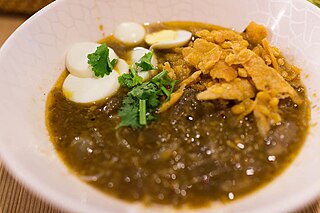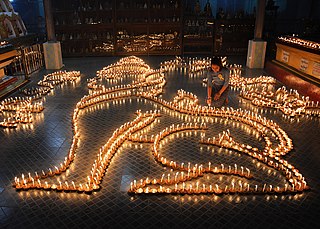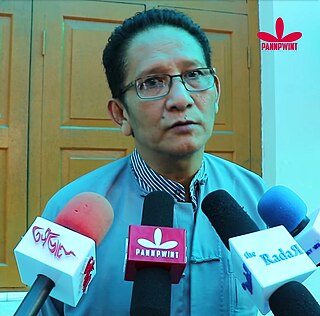
The Marma, also known as Moghs, Mogs or Maghs, are the second-largest ethnic community in Bangladesh's Chittagong Hill Tracts, primarily residing in the Bandarban, Khagrachari and Rangamati Hill Districts. They belong to the same community as the Rakhine people. Many Marmas live in Bangladesh's coastal districts of Cox's Bazar and Patuakhali, while few of them live in Tripura, India and Myanmar. There are about 224,261 Marmas living in Bangladesh and 35,722 of them living in India. Since the 16th century, the Marma have considered the Bengal's Chittagong Hill Tracts their home, where they have established the Bohmong and Mong Circles (chiefdoms).

The Bamar are a Southeast Asian ethnic group native to Myanmar. With an estimated population of around 35 million people, they are the largest ethnic group in Myanmar, accounting for 68% of the country's total population and belonging to the Tibeto-Burman group. The geographic homeland of the Bamar is the Irrawaddy River basin. The Bamar speak the Burmese language which serves as the national language and lingua franca of Myanmar.

Taunggyi is the capital and largest city of Shan State, Myanmar (Burma) and lies on the Thazi-Kyaingtong road at an elevation of 4,712 feet (1,436 m), just north of Shwenyaung and Inle Lake within the Myelat region. Taunggyi is the fifth largest city of Myanmar, and has an estimated population of 380,665 as of 2014. The city is famous for its hot air balloon festival held annually on the full moon day of Tazaungmon.

Mohinga is a rice noodle and fish soup from Myanmar and an essential part of Burmese cuisine, considered by many to be the national dish of Myanmar. Mohinga is readily available in most parts of the country, sold by street hawkers and roadside stalls in larger cities. Mohinga is traditionally eaten for breakfast, but today is eaten at any time of day.

The Water Festival is the New Year's celebrations that take place in Southeast Asian nations such as Thailand, Laos, Myanmar, and Cambodia as well as among the Xishuangbanna Prefecture of China, and the southern parts of Vietnam. It is part of the broader South and Southeast Asian solar New Year. It is called the 'Water Festival' by Westerners because they notice people splashing or pouring water at one another as part of the cleansing ritual to welcome the Songkran New Year. Traditionally, people gently sprinkled water on one another as a sign of respect, but as the new year falls during the hottest month in South East Asia, many people end up dousing strangers and passers-by in vehicles in boisterous celebration. The act of pouring water is also a show of blessings and good wishes. It is believed that at this Water Festival, everything old must be thrown away, or it will bring the owner bad luck.

Shinbyu is the Burmese term for a novitiation ceremony (pabbajja) in the tradition of Theravada Buddhism, referring to the celebrations marking the sāmaṇera (novitiate) monastic ordination of a boy under the age of 20.

The Pa'O are the seventh largest ethnic nationality in Burma, with a population of approximately 2,000,000 to 2,500,000.

Dance in Burma can be divided into dramatic, folk and village, and nat dances, each having distinct characteristics. Although Burmese dance resemble the traditional dancing style of its neighbors, in particular [Dance in Cambodia ], it retains unique qualities that distinguish it from other regional styles, including angular, fast-paced and energetic movements and emphasis on pose, not movement.

Hti, a Burmese language word meaning umbrella, is the name of the finial ornament that tops almost all Burmese pagodas. The umbrella is an auspicious symbol in Buddhism and Hinduism.
Gadaw is a Burmese verb referring to a Burmese tradition in which a person, always of lower social standing, pays respect or homage to a person of higher standing, by kneeling before them and paying obeisance with joined hands, and bowing. This is usually done by students to their teachers or children or grandchildren to their elders, in order to show gratitude and reverence and an opportunity to ask for forgiveness, often involving gift-giving.

The Tazaungdaing Festival, held on the full moon day of Tazaungmon, the eighth month of the Burmese calendar, is celebrated as a national holiday in Myanmar and marks the end of the rainy season. It also marks the beginning of the Kathina season, during which monks are offered new robes and alms.

The Thadingyut Festival, also known as the Lighting Festival of Myanmar, is held on the full moon day of the Burmese lunar month of Thadingyut. As a custom, it is held at the end of the Buddhist sabbath (Vassa) and is the second most popular festival in Myanmar after Thingyan Festival. Thadingyut festival is the celebration to welcome the Buddha’s descent from the heaven after he preached the Abhidhamma to his mother, Maya, who was reborn in the heaven.

Pagoda festivals are regular festivals found throughout Myanmar that commemorate major religious events in pagoda's history, including the founding of a pagoda and the crowning of the pagoda's hti (umbrella). Pagoda festivals are dictated by the Burmese religious calendar and often are held several days at a time. Major events in a pagoda festival typically do not coincide with Uposatha days, during which pious Buddhists observe the Eight Precepts. The majority of pagoda festivals are held during the dry season, from the months of Tazaungmon (November) to Tabaung (March). During the full moon day of Tabaung, Buddhist devotees in various parts of Myanmar also celebrate sand pagoda festivals.
The Kamein, also known as the Kaman (ကမန်), are a Southeast Asian ethnic group indigenous to Rakhine State, Myanmar, where they primarily reside, and who predominantly follow Islam. The name Kaman comes from Persian, meaning "bow". The Kaman are formally recognized by the Burmese government and classified as one of the seven ethnic groups composing the Rakhine national race. The Kaman are considered indigenous and are widely acknowledged as Burmese citizens who hold national identity cards.

Thingyan rice is a traditional Mon dish served during Thingyan, the traditional Burmese New Year. Thingyan rice is infused with water and commonly served with a salad of cured salted fish, which is blanched and fried with onions, along with sour mango or marian plum. The dish is then garnished with roasted chili peppers. Although Thingyan rice originates from the Mon people, it is now commonly prepared throughout Lower Burma.
Weddings in Myanmar, considered auspicious occasions in Burmese culture, reflect various ethnic, religious, and regional traditions. Depending on an individual's family social economic status, personal preferences and titles held, Burmese weddings can be religious or secular, and extravagant or simple. Wedding expenses are covered by the groom's family. Myanmar is a predominantly Buddhist country, and many wedding customs and traditions are influenced by Buddhism.

Zin Wine is a Burmese film actor. He won the Myanmar Motion Picture Academy Awards two times and served as the chairperson of the Myanmar Motion Picture Organization twice as well.

Mont lone yay baw is a traditional Burmese dessert commonly associated with the Thingyan season.

The Myanmar civil war, also called the Burmese Spring Revolution, Burmese civil war or People's Defensive War, is an ongoing civil war following Myanmar's long-running insurgencies, which escalated significantly in response to the 2021 military coup d'état and the subsequent violent crackdown on anti-coup protests. The exiled National Unity Government and major ethnic armed organisations repudiated the 2008 Constitution and called instead for a democratic federal state. Besides engaging this rebel alliance, the junta also contends with other anti-junta forces in areas under its control. Hannah Beech of The New York Times observed the insurgents are apportioned into hundreds of armed groups scattered across the country.



























